Samsung Galaxy S 6 and S 6 Edge: Preview
by Joshua Ho on March 26, 2015 9:00 AM EST- Posted in
- Smartphones
- Samsung
- Mobile
- Galaxy S6
- Galaxy S6 Edge
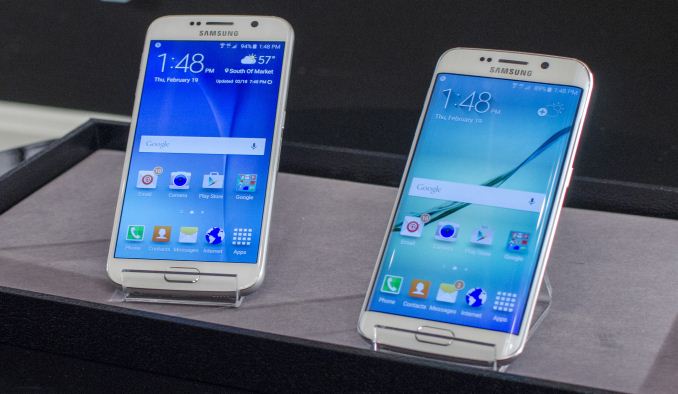
Yesterday we received our Galaxy S6 and S6 edge review units. We’re still working on the final review but I wanted to share some early results from both devices. For those that are unfamiliar with these two phones, the Galaxy S6 range represents the result of Samsung’s “Project Zero”. In fact, the phones seem to have the internal name of Zero, which can be seen in terminal, and the build properties of both devices. For Samsung, these phones represent their attempt at completely rethinking how Samsung makes phones. There is a strong emphasis on a new unibody design, which has no visible gaps or screws. Rather than the plastic that previous Samsung phones have been known for, the new design is composed of metal and glass. Samsung’s design team has been given unprecedented control throughout the process of making this phone and the result of this is a Galaxy phone that looks unlike anything else they’ve ever released.
Even if design is important, it isn’t enough to make the phone. Samsung has also outfitted the Galaxy S6 and S6 edge with their latest technologies, from a new AMOLED display to a new camera module. The specs for both phones can be seen below.
| Samsung Galaxy S5 | Samsung Galaxy S6 | Samsung Galaxy S6 Edge | |
| SoC | MSM8974ACv3 2.45 GHz Snapdragon 801 | Exynos 7420 2.1/1.5GHz A57/A53 | Exynos 7420 2.1/1.5GHz A57/A53 |
| RAM/NAND | 2GB LPDDR3 16/32GB NAND + microSD |
3GB LPDDR4-1552 32/64/128GB NAND |
3GB LPDDR4-1552 32/64/128GB NAND |
| Display | 5.1” 1080p SAMOLED HD |
5.1” 1440p SAMOLED |
5.1” 1440p SAMOLED, Dual Edge |
| Network | 2G / 3G / 4G LTE (Qualcomm MDM9x25 UE Category 4 LTE) | 2G / 3G / 4G LTE (Category 6 LTE) | 2G / 3G / 4G LTE (Category 6 LTE) |
| Dimensions | 142 x 72.5 x 8.1 mm, 145 grams | 143.4 x 70.5 x 6.8mm max, 138 grams | 142.1 x 70.1 x 7.0mm max, 132 grams |
| Camera | 16MP (5132 x 2988) Rear Facing with 1.12 µm pixels, 1/2.6" CMOS size, 31 mm (35mm effective), f/2.2 | 16MP (5132 x 2988) Rear Facing w/ OIS, f/1.9, object tracking AF | 16MP (5132 x 2988) Rear Facing w/ OIS, f/1.9, object tracking AF |
| 2MP Front Facing | 5MP Front Facing, f/1.9 | 5MP Front Facing, f/1.9 | |
| Battery | 2800 mAh (10.78 Whr) | 2550 mAh (9.81 Whr) | 2600 mAh (10.01 Whr) |
| OS | Android 4.4 w/TouchWiz |
Android 5 (64-bit) w/TouchWiz | Android 5 (64-bit) w/TouchWiz |
| Connectivity | 802.11a/b/g/n/ac 2x2 + BT 4.0 (BCM4354), USB3.0, GPS/GNSS, MHL, DLNA, NFC |
2x2 802.11a/b/g/n/ac + BT 4.1 (BCM4358), USB2.0, GPS/GNSS, NFC |
2x2 802.11a/b/g/n/ac + BT 4.1 (BCM4358), USB2.0, GPS/GNSS, NFC |
| Wireless Charging | N/A | WPC 1.1 (4.6W) & PMA 1.0 (4.2W) |
WPC 1.1 (4.6W) & PMA 1.0 (4.2W) |
| Fingerprint Sensor | Swipe | Touch | Touch |
| SIM Size | MicroSIM | NanoSIM | NanoSIM |
Both the Galaxy S6 and S6 edge have Samsung System LSI’s newest SoC, the Exynos 7420, which has a cluster of four Cortex A57s clocked at 2.1 GHz, and four Cortex A53s clocked at 1.5 GHz. Compared to the Exynos 5433 of the Galaxy Note 4, this brings a new 14nm LPE (low power early) process, an upgrade to LPDDR4 memory, and a Mali T760 GPU with two additional shader cores. Outside of the SoC, the new display is advertised to bring a higher 600-nit brightness and a higher 1440p resolution. The front and rear cameras are both different from the Galaxy S5 as well, although the rear camera sensor may be shared between the two as the camera sensors are of similar spec. For this preview, we’ll focus on the system performance and display of these new devices, but as one can see from the specification table there is far more to look at for the full review.
System Performance
For our system performance benchmarks we’ll start with our browser tests which can give a rough proxy for overall CPU performance.
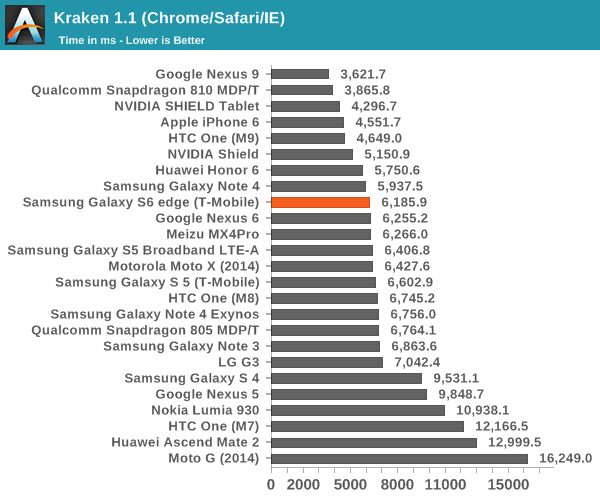
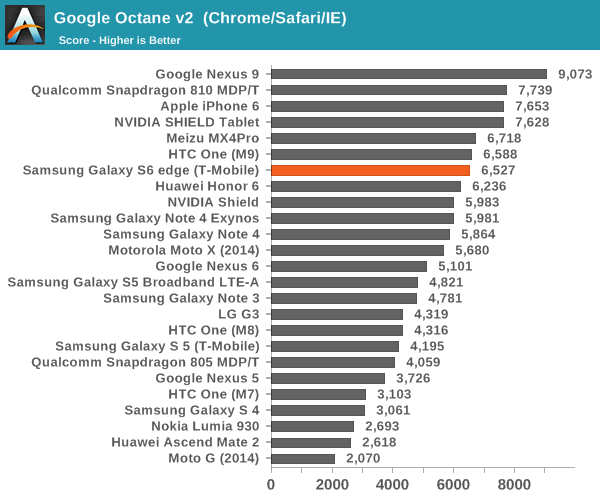
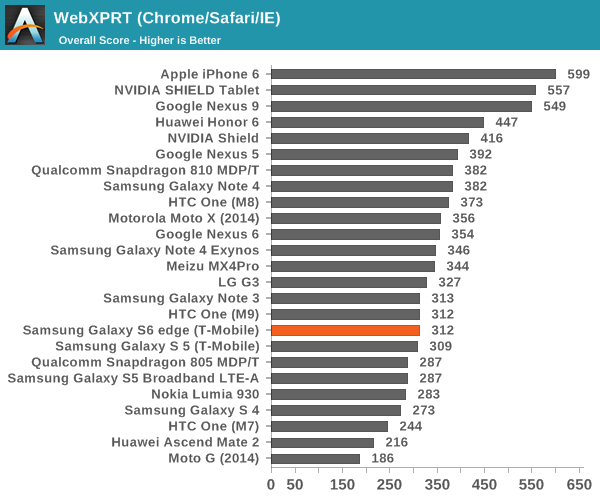
The Exynos 7420 is about on par with the Snapdragon 810 in these benchmarks. Strangely enough both tend to do worse than the Huawei Honor 6 in these tests, which clearly can't be correct. As we've previously discussed, the stock browser will often give far better results due to OEM and SoC vendor optimizations. As a part of our updates to the benchmark suite for 2015, we'll take a look at Basemark OS II 2.0, which should give a better picture of CPU performance in addition to overall device performance.
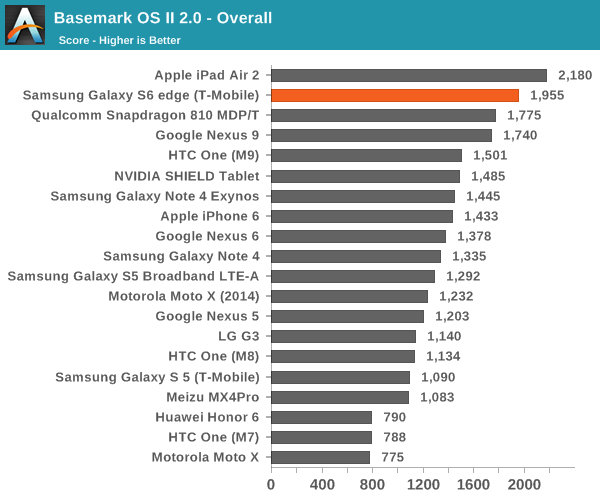
The browser benchmarks seem to hide some pretty enormous variability as the Galaxy S 6 edge (which is comparable to the Galaxy S 6) sets a new record among Android devices. The only challenger is the iPad Air 2, which uses the A8X SoC with three Enhanced Cyclone cores and the semi-custom GXA6850 GPU.
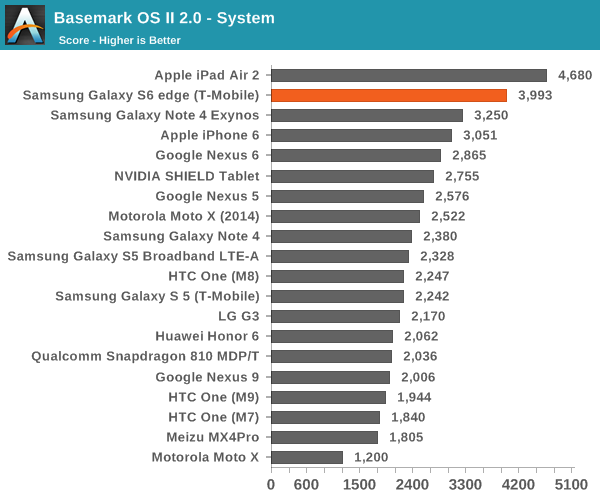
This system test contains a floating point and integer test, in addition XML parsing, which means that this test mostly stresses CPU and RAM. Interestingly enough, the Exynos 7420 pulls far ahead of both the Exynos 5433 and Snapdragon 810 in this test, and approaches the A8X. The difference between the 5433 and 7420 is likely a combination of the higher clocks on both the A57 and A53 clusters for the 7420 (1.9/1.3 on the 5433, 2.1/1.5 on the 7420), in addition to the ability to stay at a high 'overdrive' clock due to reduced leakage from the 14LPE process. The One M9 likely falls a bit short here due to HTC's governor settings restricting the use of all 8 cores simultaneously.
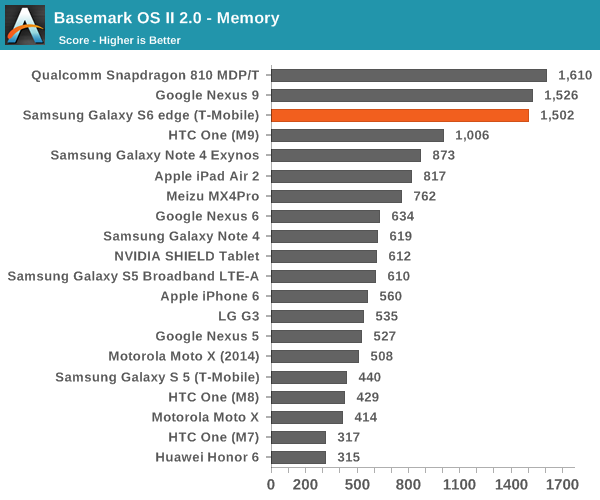
While one might guess that the memory test of 'Basemark OS II 2.0 - Memory' is of RAM, this is actually a test of the internal storage. Once again we see the S6 edge come close to leading the pack due to the use of the new UFS (Universal Flash Storage) standard. Casual examination reveals that the S6 edge has a queue depth of 16, and that it identifies itself with the rather cryptic model name of KLUBG4G1BD-E0B1.
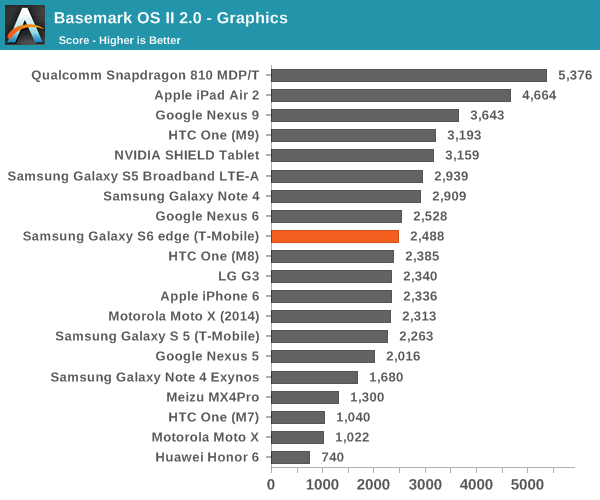
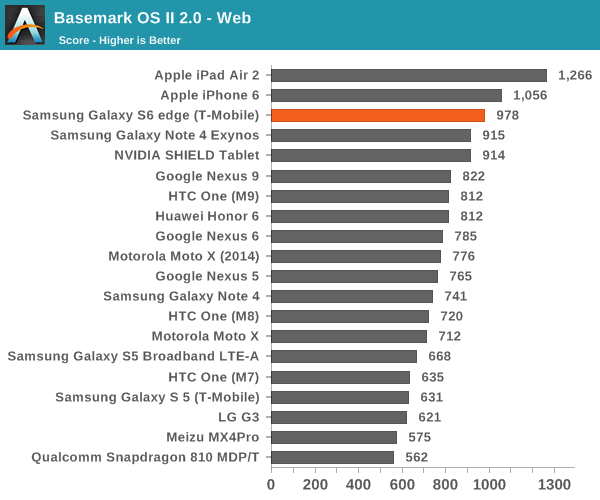
For the web test, it uses the built-in WebView rendering engine rather than Chrome and paints a distinctly different picture, especially because these tests are focused on HTML5 and CSS rather than JavaScript. Here we can see that the iPhone 6 and iPad Air 2 continue to hold their lead, but the Galaxy S6 is pretty much the king of the hill when it comes to Android devices.










200 Comments
View All Comments
hp79 - Sunday, March 29, 2015 - link
I understand that the screen does use more CPU power, but how do you know if going with 1080p will give you 2 days battery life instead of 1? I don't think the screen resolution will make that much difference on battery life. What really makes the difference is the battery capacity (they went smaller so this is bad), and newer process (power efficiency gone up).I haven't tried a 1440p on a phone yet, but I've noticed immediately how different a 720p vs 1080p on a 4.5" screen is, while a lot of people were claiming human eye can't detect any difference. I think it's the same thing happening here. I'm pretty sure the photos will look much better on a 1440p screen compared to 1080p. I want my screen to be real life-like sharp and clear, and I think 1440p will bring that.
The 1440p screen is also needed for virtual reality application where you split the screen for left and right eye, then the resolution really matters and we might want even more higher resolution. Of course, VR will have to take off before that but still, I think VR is much easier to take off than gimmicky smart watch or the not-so-popular 3D TVs.
MercuryHero - Tuesday, April 14, 2015 - link
Their AMOLED screens are way more efficient than they used to be in terms of light output per energy used, so they're essentially offsetting their efficiency gains with a higher resolution.It's a balance that they have to maintain between actually benefiting from the improved efficiency versus offsetting against it to boost specs without losing much efficiency, and in this case I am on your side, because I don't have any reason for anything more than 1080p in Pentile, and I'd rather they balanced a little more in favour of actually giving us some battery savings rather than creeping the specs arguably beyond where they would be useful. I'd hate to look like an idiot in 4 years when everyone has 4k Ultra HD screens on their phones but I just don't see any point to going beyond about 300ppi for RGB stripe or a little higher for Pentile.
1announcer - Friday, March 27, 2015 - link
Why not just buy an IPhone? When you don't have an SD card or replaceable battery you just have an IPhone running android. I'll stick with my S5 until Samsung wakes up and gives me something to be happy about. Those cheep Chinese phones with SD cards and replaceable batteries are looking better and better.chizow - Saturday, March 28, 2015 - link
Basically, that's what I ended up doing after Samsung stripped the only 2 things I actually bought their phones for. If it comes down to Android vs. iOS experience, iOS wins, although I do prefer Google Play for the random/obscure apps you'll find there.MercuryHero - Tuesday, April 14, 2015 - link
The cheap Chinese phones typically run older versions of Android, never offer any upgrades and often there are no developers making third party ROMs either. So you may be on Android 4.3 even in 2 years' time. And what's more the firmware is a lot buggier than what you'd come to expect from HTC or Samsung, coupled with the fact few app developers will test on such devices, uncovering weird bugs in lots of apps.I speak from experience and I've gone back to high end Samsung phones, albeit I still save money by not buying the latest model. For instance I have a Galaxy Note II that's almost 3 years old and it has Kitkat and works better than modern mid-range phones even things like the Galaxy S5 mini.
Apple is very good at keeping software updated on their phones too, traditionally even better than Samsung's flagship phones. There are other reasons people may prefer Android over Apple than removable storage or batteries though.
Mrduder11 - Saturday, March 28, 2015 - link
I don't meant to start an Apple vs Samsung war but seriously for a premium handset that comes out 6 months later then the iPhone 6 I feel like these results are very overwhelming. Overall performance is underwhelming compared to the iPhone 6. I understand benchmarks don't tell the whole story but I am surprised to see lower performance from the S6. Also why has the iPhone 6 Plus results been removed from the performance and display charts?halcyonmax - Saturday, March 28, 2015 - link
How so? In CPU performance S6 more or less comes at the top.Where it seems to be lacking is the GPU department but thats basically because of the insane resolution.Still in the off-screen tests the GPU has good scores.The browser based CPU benchmarks do seem to paint another picture but such benchmarks are greatly affected by the browser optimization.Check out the htc m9 review..there anandtech has listed the stock browser scores of s6 and they seem to be pretty impressive.Other than these the missing sd slot and battery seem to be the let down. IF phonearena's battery tests are to be believed s6 is far better than the iphone in the battery department and gives similar performance as its predecessor despite the smaller battery..however it has faster charging speed.MercuryHero - Tuesday, April 14, 2015 - link
You cannot meaningfully compare performance between two completely different platforms with a software benchmark; they are measuring different things on the different platforms because everything - right down to low level instructions - that the respective benchmark apps do is different.I can understand how easy it is to infer equivalency when they are shown in the same chart like that; I'd disagree with the practice of combining them into a single chart.
Ahnilated - Saturday, March 28, 2015 - link
Well I was all excited to get the new S6 Edge until I read that you couldn't remove the battery and it didn't have removable storage. That makes it a no go for me period.AnnonymousCoward - Monday, March 30, 2015 - link
Your sentence already ended with a period. There's no point in saying that word.